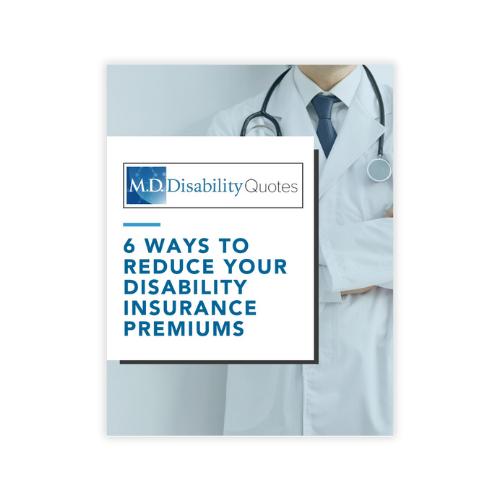FIND THE RIGHT PLAN FOR YOU
Life Insurance Guide for Physicians 2024
What You Need To Know About Life Insurance in 2024
Discover all you need to know about life insurance in 2024 with our guide! Gain knowledge on various types of policies, as well as the significance of having life insurance.
Life insurance serves as vital method of saving money and ensuring your family’s financial security in the event of your passing. It can offset the loss of income and supply financial resources to your loved ones or designated beneficiaries. If you are someone who financially supports others, it is likely that you require life insurance. At M.D. Disability Quotes, we only suggest life insurance if there is a genuine need.
What is Life Insurance?
Life insurance is a contract between an insured party and an insurer. The insurer agrees to pay a designated beneficiary a certain amount of money upon the death of the insured party. It is designed to protect your loved ones by providing them with financial security in the event you pass away. Your life insurance policy ensures that your family can continue to have their basic needs met even after your death. Life Insurance is a way to transfer risk away from your family or dependents you are responsible for, by providing them with cash payment called a death benefit. The goal is to leave enough cash behind to pay for expenses that your income would otherwise cover.

Did you know?
41%
say they need life insurance – or more of it
59%
would feel more secure in their relationship if they discussed getting life insurance with their partner
40%
say they are uncomfortable with end-of-life discussions
Life insurance can fulfill various financial requirements, including paying off debts, covering children’s healthcare costs, providing for primary and college education, and supplying income to surviving family members who rely on you. Additionally, life insurance can be viewed as a means of accumulating savings that guarantees a desired level of wealth of your loved ones in the event of your passing. It is also recognized as an efficient method of transferring wealth from one generation to the next.
Advantages of Life Insurance
How much can you apply for?
| Age | Multiple of Earned Income |
|---|---|
| 18-35 | 30 |
| 36-45 | 25 |
| 46-60 | 20 |
| 61-65 | 10 |
| 66+ | 5 |
Types of Life Insurance
Term Life Insurance
Term life insurance is the least expensive cost for the amount of protection upfront. If you’ve ever had life insurance coverage through an employer, this is probably what it was. Term life works by protecting you for a certain period of time — or a term. That term can be 10, 20 pr even up to 40-years now.
During that time, you’re protected so long as you continue to pay premiums. If you die during the term that your insurance is active, your beneficiary or beneficiaries receive payments
Your need may only be for a shorter period of time so this could be the best solution for you.
Examples of this could be that you might only need insurance coverage until your kids are finished with college or until you retire. If term life insurance is appropriate for you now; however, you aren’t 100% sure that the need will end at a certain period, most policies have a solution built-in for that. Most term life insurance is convertible, meaning you can transfer your term insurance to an equal amount of permanent coverage in the future. This changes the costs significantly but could be a back up plan if your health changes and you are no longer eligible but need coverage for an unexpected dependency, a business venture, etc.
The types of products that are available do depend on the carrier of choice. There are only a handful of carriers that offer more than one choice of coverage to convert into.
Because a term policy doesn’t build cash value and isn’t in force for the entire duration of your life, term coverage can be far more affordable than other types of life insurance for a temporary need.
Term life insurance is appropriate for families and individuals who only need coverage for a limited amount of time, or are looking to insure themselves for a smaller amount of money.
Whole Life Insurance
Hybrid life insurance policies are becoming more popular due to the recent legislation in certain states. Insurance products combine a life insurance policy base with “Living Benefits” for Long-Term Care. The goal in the state of WA was to allow for the exemption and during that window, WA State did allow for some of the underwritten LTC riders to be part of the exemption and you may hear about Regulation 7702 when looking into some of these rules.
Universal Life Insurance
6 Life Stages that Trigger the Need for Life Insurance
Get peace of mind knowing your family is protected
How Much Life Insurance Do You Need?
5 Reasons Why Getting Life Insurance is an Easy Decision
Life Insurance FAQ's
AIG Partners, Ameritas, Assurity, Cincinnati Life, Columbus Life, American General, Equitable, Fidelity Life, John Hancock, Legal & General America (Banner), Lincoln Financial, Mass Mutual, Mutual of Omaha, National Life Group, Nationwide, North American, Pacific Life Broad Market, Principal, Protective, Prudential, SBLI, Securian, Symetra and Transamerica.
Thinking about buying term life insurance? We’ve got everything covered as an independent brokerage, we listen to your situation and shop for you depending on your needs. From understanding basics to finding the best price, explore our advice on getting the right policy for your needs. Get a Quote.
Yes. If you are diagnosed with a terminal illness and have a short life expectancy, the Accelerated benefit or the Terminal Illness Benefit will allow you to pull a portion of your death benefit amount forward. The rest of the death benefit balance is available to pay your chosen beneficiaries upon your death.
No. The benefits can be used for whatever you see fit such as expenses for care or time to put your affairs in order. Pay for end-of-life care, travel; anything you would prefer for your family’s needs during this time.
Living Benefits can be considered when there is a chronic illness occurring. This allows the owner of the policy to accelerate a portion of the face amount forward. It sounds a lot like the Accelerated Benefits Rider but performs more like the riders discussed on our Extended Care section. Chronic Illnesses are those that are preventing you from performing Activities of Daily Living or having severe cognitive impairments. This section is covering these riders at a high level so please see our Extended Care page for more information. It is important to know that these are not considered Long-Term Care policies but are riders that can be triggered inside of term life insurance products. These riders have rules and qualifications that are subject to the carrier, state pricing and a person’s health.
We have seen these term life insurance products become popular recently and a handful of carriers are now offering it. These are not LTC plans however, these will allow for certain benefits to be use while living but unwell. If you advance forward the allowable % of benefits out of your policy, your family will receive the difference between the amount use and what is left out of the death benefit.
- Disability Waiver of Premium Rider – this will allow for a person who is disabled to stop making payments on their life insurance policy. This can free up cash flow for other expenses that may need to be used for care vs premiums for insurance; while keeping the policy active. Some policies that offer Living Benefits will waive premiums if you are chronically ill. Waivers of premium typically have a cost on permanent insurance.
- Endowment Benefit Rider (also known as Return of Premium Rider) (available on 20-year and 30-year policies; returns premium paid on base policy and Return of Premium Rider only). [link that section]
- Monthly Disability Income Rider
- Accident-Only Disability Income Rider
- Children’s Term Rider insures each child when you have your approval for life insurance and any subsequent children born after the policy is in effect can also be added to the policy. These riders have an expiration date and it typically around age 25. They do have the right to change the policy at this time and this could be useful if a child isn’t healthy enough to obtain their own policy.
- Extended Conversion Rider: This is sometimes needed depending on the carrier to ensure you can convert your coverage in the future. Once the period begins on issue date and ends on the earlier of one year prior to the end of level term period for 10-year plan; or, two years prior to the end of level term period on 15-, 20- and 30-year plans; or, policy anniversary on which the insured attains age 65
- What is an Accelerated Death Benefit? This is allowing for the funds to be used before death, to pay for expenses. Depending on the contract at hand, it is possible to advance forward benefits out of a policy if terminal. Subject to the state and product guidelines.
– You will hear Terminal Illness, Chronic Illness and Critical Illness being used in these conversations. It is important to obtain a full explanation rom the carrier to learn what they offer as you may only have the Accelerated Death Benefit with most term life products. - What is a Chronic Illness Rider?
New regulations allow for some chronic illness riders to pay claims if the condition is temporary. However, most chronic illness riders still require the condition to be permanent. These are triggered based upon ADLs. - What is a Critical Illness Rider? This rider, if offered, covers a list of diagnosed critical illnesses. You would want to obtain that list for review to determine if this policy is right for you.
**Please note that some of these riders aren’t available in certain states.**
Most plans require Medical Underwriting before allowing you to be approved for coverage. However, many updated Life products are now offering Accelerated Underwriting. This type of underwriting typically involves a competitively priced, guaranteed-premium term life insurance policy and is algorithm based, up to certain amounts of coverage.
The Accelerated Underwriting process uses real-time data to provide instant approvals on up to 50 percent of applicants who qualify based on age, personal history, and face amount requirements. There is a catch to this though. These systems will be looking at a life score, called a TRL score, which can pull credit and look at other factors that wouldn’t otherwise be negatively viewed during traditional underwriting. What we mean by this is that if you are in the middle of a house purchase, your TRL score could push you from preferred plus (best rates) to a preferred rate all due to algorithms. If you want to be sure your health is valued, talk with an independent broker to be sure that you know whether an accelerated program will be best for you.
Some applicants may qualify for an instant decision and have their policies issued in a matter of a few days. Please note that while using specific algorithms, sometimes you may start with accelerated but wind up I traditional underwriting anyway. If your medical history and/or other questions are answered in a way that isn’t satisfying to the algorithm, you may be asked to schedule a paramedical appointment with their exam team anyway.
Some carriers use a TRL Score to evaluate lifestyle and that can sometimes alter the offer from being best in health to a preferred status; sometimes by just having a change in credit score for a house purchase. These factors are typically going to warrant a traditional or full underwriting situation.
- Face amounts above $500,000 for ages 18-50, but some carriers are going as high as 2M and this could be subject to change
- Height and Weight called a “build” is outside of the allowable weight limits [link that table]
- History of bankruptcy in the last 2 years
- DUI or reckless driving charges in the last 2 years
- Prior felony conviction
- High-risk activities or hobbies like private aviation or skydiving
- Prescription drugs taken for, or a history of the following conditions: – AIDS/HIV – Cancer – Chronic pulmonary disease – Kidney disease – Psychiatric and Bipolar disorders – Multiple Sclerosis (MS) – Heart disease – Parkinson’s disease – Stroke
Women have special considerations that should be considered when shopping for coverage or adding onto current coverage. You can find more information here.
There are alternatives for those who cannot qualify for the plans mentioned or do not want to purchase a plan.
- Pay for a contract with a rating
- Buy a Term Life Policy Accelerated Benefit Rider
- Apply for a Home Equity Conversion Mortgage, a reverse mortgage (HECM)
- Consider a Single-Premium Immediate Annuity (SPIA)
Millennials and Gen Z
The fast-growing millennial market, 48% of which say they plan to buy life insurance within the next 12 months. Gen Z reports to be very involved with financial independence.
Families
Families can use optional riders to extend coverage for multiple needs, with the option to convert to permanent coverage later. Planning for the end of life can be uncomfortable but can take the pressure off of a family when planning in advance vs. when there are problems in the future.
Workers
Almost half don’t have access to coverage through their employer, and when they do the median amount is only $50,000 through their employer as a free benefit to them.
Business Owners
Business owners are often asked to secure life insurance as part of securing a loan for financing a new practice. Additionally, owners and partners look to these policies for ways to fund a Buy-Sell Agreement so that owners and spouses are able to be compensated if one of the owners passes away.
If you own a business, it might be necessary to acquire a life insurance policy for the business.
What are some criteria to determine if this is some you should consider?
- Would the business suffer if it lost a key employee in case of an untimely death?
– This helps to avoid negative impacts on the businesses profitability. - Are you currently work on a Buy-Sell Agreement between partners?
– A life insurance policy is commonly used to protect a partner if the other partner(s) were to pays away. This policy then buys out the other using the death benefits. - How else is life insurance considered in business?
– A life insurance policy could fund a nonqualified executive compensation plan if additional compensation is needed outside of traditional employer sponsored plans.
Often, a business partner would purchase a term policy to cover the needs if the need was for a limited time. They may also need to consider a disability policy for the business as well.
Some partners may want an Annual renewable term policy vs. level term life insurance. ART policies are usually not much cheaper than a 10-year term but is available but it isn’t the most common choice. In most cases, the Annual Renewable Term premium is only cheaper for the first 2 or 3 years before it becomes more expensive than the 10 year term.
- ART is sometimes used in a Buy-sell situation where they only need term coverage for a couple years.
- ART could be a strategy when a Term Life conversion makes sense in a few years. For example, client was issued tobacco rates and has plans to go thru UW to get non tobacco rates before converting to permanent.
Take the first step towards securing your loved ones' future
Life Insurance Resources
Related Posts
Related Videos









